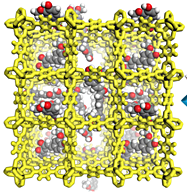Methods for Establishing Drug Supersaturation from a Porous Host
TECHNOLOGY NUMBER: 2019-069

OVERVIEW
A safe and effective method to solubilize poorly soluble drug candidates- Enables oral delivery of poorly water soluble active pharmaceutical ingredients (APIs)
- Versatile approach suitable to a variety of APIs
BACKGROUND
Oral delivery is the preferred drug delivery route because of its convenience, high patient compliance, and cost-effectiveness. The drug must first dissolve in the gastric fluids before it can pass through the stomach lining and enter the bloodstream. However, the oral route presents several challenges. The acidic environment of the stomach and the presence of digestive enzymes can degrade some drugs before they can be absorbed. Additionally, the drug must be able to permeate through the gastrointestinal mucosa, which can act as a barrier to absorption. Therefore, to be effectively delivered orally, the active pharmaceutical ingredient (API) must demonstrate high solubility in gastric and other physiological media to achieve effective absorption. As a consequence, otherwise promising drug candidates that suffer from poor aqueous solubility are often abandoned in pharmaceutical R&D. Commercially viable, generalizable methods of solubilizing these promising compounds are urgently needed.
INNOVATION
Researchers at the University of Michigan have developed a metal-organic framework (MOF) system that has been shown to effectively increase the solubility of three distinct candidate compounds that otherwise demonstrate poor aqueous solubility, particularly in gastric media. The MOF acts as a drug carrier in the solid state but undergoes rapid decomposition upon introduction to aqueous media in physiological conditions. The result is a rapid release of the drug, leading to higher concentrations of the API in solution than are otherwise achievable. This supersaturation is sustained over several hours, providing for a large window in which the absorption of the compound into the bloodstream occurs at elevated rates.
Upon exposure to physiological media, the MOF scaffold rapidly decomposes to its individual components, which are known to be non-toxic and easily processed by the human body. The MOF system has been shown to be effective with three different drug compounds already and should prove generalizable to a number of potential drug candidates. Furthermore, this novel approach can be applied to other water-reactive MOFs to expand the scope of candidate compounds that may be delivered with this general approach.